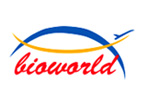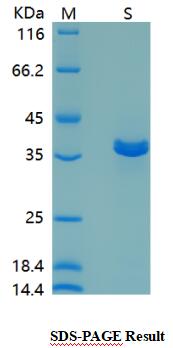Product Name :
CD358 Recombinant Protein Swiss-Prot :
O75509 Host :
E.coli Tag :
≥0.5mg/ml Amino acid Sequence :
QPEQKASNLIGTYRHVDRATGQVLTCDKCPAGTYVSEHCTNTSLRVCSSCPVGTFTRHENGIEKCHDCSQPCPWPMIEKLPCAALTDRECTCPPGMFQSNATCAPHTVCPVGWGVRKKGTETEDVRCKQCARGTFSDVPSSVMKCKAYTDCLSQNLVVIKPGTKETDNVCGTLPSFSSSTSPSPGTAIFPRPEHMETHEVPSSTYVPKGMNSTESNSSASVRPKVLSSIQEGTVPDNTSSARGKEDVNKTLPNLQVVNHQQGPHHRHILKLLPSMEATGGEKSSTPIKGPKRGHPRQNLHKHFDINEH Restriction sites :
NdeI-XhoI Background :
The tumor necrosis factor receptor family, which includes TNF-RI, Fas, DR3, DR4, DR5, and DR6, plays an important role in the regulation of apoptosis in various physiological systems. The receptors are activated by a family of cytokines that include TNF, FasL, and TNF-related apoptosis-inducing ligand (TRAIL). They are characterized by a highly conserved extracellular region containing cysteine-rich repeats and a conserved intracellular region of about 80 amino acids termed the death domain (DD). The DD is important for transducing the death signal by recruiting other DD containing adaptor proteins (FADD, TRADD, RIP) to the death-inducing signaling complex (DISC), resulting in activation of caspases. DR6, also known as TNFRSF21, is a TNFR family member able to induce apoptosis as well as activation of NF-κB and JNK. Expression of DR6 is upregulated by NF-κB signaling. DR6 appears to play a critical role in the activation and differentiation of T and B lymphocytes. In the nervous system, β-amyloid precursor protein (APP) activates DR6 to trigger neuronal degeneration. Soluble :
PBS, 4M Urea, PH7.4 Purification&Purity :
Transferred into competent cells and the supernatant was purified by NI column affinity chromatography and the purity is > 85% (by SDS-PAGE). Storage&Stability :
Store at 4°C short term. Aliquot and store at -20°C long term. Avoid freeze-thaw cycles. Expression vector :
pet-22b(+) BiowMW :
~34kDa Note :
For research use only, not for use in diagnostic procedure. concentration :
≥0.5mg/ml
CD358 Recombinant Protein Swiss-Prot :
O75509 Host :
E.coli Tag :
≥0.5mg/ml Amino acid Sequence :
QPEQKASNLIGTYRHVDRATGQVLTCDKCPAGTYVSEHCTNTSLRVCSSCPVGTFTRHENGIEKCHDCSQPCPWPMIEKLPCAALTDRECTCPPGMFQSNATCAPHTVCPVGWGVRKKGTETEDVRCKQCARGTFSDVPSSVMKCKAYTDCLSQNLVVIKPGTKETDNVCGTLPSFSSSTSPSPGTAIFPRPEHMETHEVPSSTYVPKGMNSTESNSSASVRPKVLSSIQEGTVPDNTSSARGKEDVNKTLPNLQVVNHQQGPHHRHILKLLPSMEATGGEKSSTPIKGPKRGHPRQNLHKHFDINEH Restriction sites :
NdeI-XhoI Background :
The tumor necrosis factor receptor family, which includes TNF-RI, Fas, DR3, DR4, DR5, and DR6, plays an important role in the regulation of apoptosis in various physiological systems. The receptors are activated by a family of cytokines that include TNF, FasL, and TNF-related apoptosis-inducing ligand (TRAIL). They are characterized by a highly conserved extracellular region containing cysteine-rich repeats and a conserved intracellular region of about 80 amino acids termed the death domain (DD). The DD is important for transducing the death signal by recruiting other DD containing adaptor proteins (FADD, TRADD, RIP) to the death-inducing signaling complex (DISC), resulting in activation of caspases. DR6, also known as TNFRSF21, is a TNFR family member able to induce apoptosis as well as activation of NF-κB and JNK. Expression of DR6 is upregulated by NF-κB signaling. DR6 appears to play a critical role in the activation and differentiation of T and B lymphocytes. In the nervous system, β-amyloid precursor protein (APP) activates DR6 to trigger neuronal degeneration. Soluble :
PBS, 4M Urea, PH7.4 Purification&Purity :
Transferred into competent cells and the supernatant was purified by NI column affinity chromatography and the purity is > 85% (by SDS-PAGE). Storage&Stability :
Store at 4°C short term. Aliquot and store at -20°C long term. Avoid freeze-thaw cycles. Expression vector :
pet-22b(+) BiowMW :
~34kDa Note :
For research use only, not for use in diagnostic procedure. concentration :
≥0.5mg/ml
Blocking peptide available as NCP0307P

 CD358 Recombinant Protein
CD358 Recombinant Protein 
 Datasheet
Datasheet COA
COA MSDS
MSDS SHIP
SHIP